Viewing Network Server Diagnostics
Ektron's Diagnostics Utility provides the following comprehensive information about your network's servers that are related to the website to which you are logged on. (An Ektron network consists of your Ektron server, connected database servers, and other servers with which your website has an Synchronizing Servers Using eSync or Load Balance relationship.)
- status of all services
- version information for Windows, SQL, IIS, Visual Studio, and so on
- event log
- database connection status, test query, server, and so on
- for each server: drive capacity and available space; available memory, and so on
- eSync information, such as remote certificates for this server
NOTE: Most Diagnostics fields are read-only but the utility lets you perform a few actions.
The following video link provides additional information about the Diagnostics Utility: The Making of Ektron eSync Diagnostics.
- The Diagnostics Utility uses a Workarea Web service that is installed to the Ektron server. This service runs independently of the Ektron Windows Service and your Ektron website.
- That Web service routes requests to the Ektron Diagnostics Service.
- The Ektron Diagnostics Service collects diagnostic information from the database, website files, and other locations like the event log. It also scans for other known Web servers (eSync servers, load balance servers, and multi-site servers).
- If any other servers are found, the Diagnostics Windows Service opens a connection to the destination server's Diagnostics service. The Diagnostics Service uses the same port as the Ektron Windows service.
- The Ektron Diagnostics Service returns the collected data to the Silverlight viewer, which dynamically builds the network that appears on the screen.
Installing the Diagnostics Utility
You should install the utility to every website and server in your Ektron network. This includes Ektron Web servers, as well as servers used in Load Balance and eSync configurations. You do not need to install the utility on client workstations.
You can install the Diagnostics Utility as a site option during the installation or upgrade of Ektron (see Diagnostic Utility checkbox).

If Diagnostic Utility was not checked during installation, you can install it by going to Windows Start button > All Programs > Ektron > CMS400vxx > Utilities > Ektron Diagnostic Utility.
The Diagnostics Utility installs the following files on each server.
web.configfile additions- the Ektron Diagnostics Windows service
NOTE: If the Diagnostics Utility is not installed on a server, a node for that server appears, but information about it is not available in the lower section of the screen, and additional relationships are not visible.
For example, you have an eSync relationship between development and staging servers, and between staging and production servers. If the Diagnostics Utility is installed on the development server but not on staging, and you view the network from the development Workarea, you see nodes for development and staging, but not production. You can view details for development, but not staging.
Running the Diagnostics Utility
Prerequisites
- You are a member of the Ektron Administrator's group
- The Diagnostics Utility was installed on every server with which your website has an eSync or Load Balance relationship
- The Diagnostics Utility requires Silverlight 4. If a client does not have it, you are prompted to install it before you can view the screen.
To access the Diagnostics Utility, go to Workarea > Settings > Configuration > Diagnostics. The Diagnostics screen consists Ektron network nodes connected by lines that indicate relationships. Use the slider on the right side to adjust the zoom level.
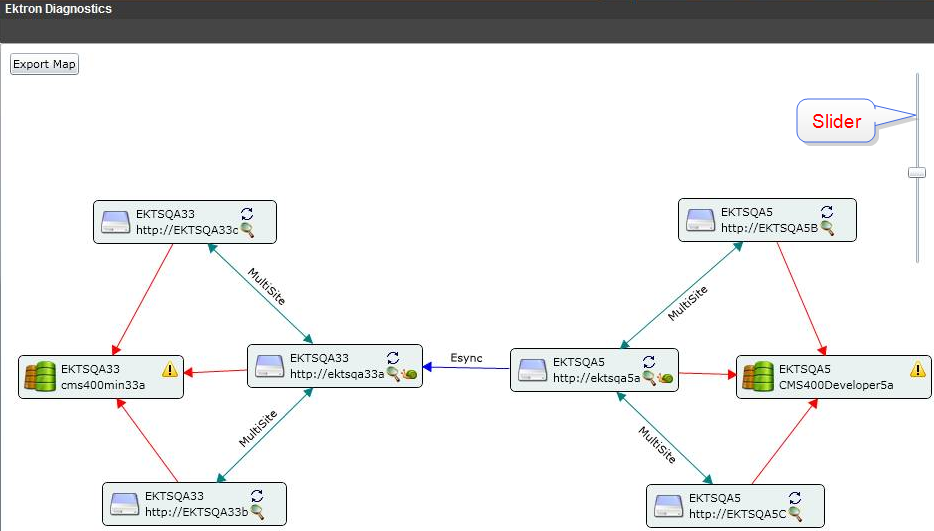
You may drag the nodes around for easier viewing.
Connecting Lines on the Diagnostics Screen
A connecting line's color indicates the type of relationship that exists between nodes.
- Blue—eSync
The arrowhead direction indicates the direction of the profiles. For example:
- no arrowheads—no profiles
- 2 arrowheads—one upload and one download profile exists between servers
- Red—Database server
Appears even if the database resides on the same server with Ektron.
- Green—Load balance
- Teal—Multi-site
Network Node Icons
The following icons may appear in a network node.
![]()
-
 Analysis— Reports server's installed memory, available memory, and available disk space. Click the icon for more information. See Also: Analyzing System Memory and Disk Space
Analysis— Reports server's installed memory, available memory, and available disk space. Click the icon for more information. See Also: Analyzing System Memory and Disk Space -
 Bandwidth test—Reports speed of server's connections. Click the icon for more information. Testing Bandwidth
Bandwidth test—Reports speed of server's connections. Click the icon for more information. Testing Bandwidth -
 Refresh—For selected node, load or reload Viewing Diagnostic Details. Click the icon for more information.
Refresh—For selected node, load or reload Viewing Diagnostic Details. Click the icon for more information. -
 Warning—When hovered over, displays a warning about the node. For example, if your database resides on an Ektron server, you are advised to move the database to its own server.
Warning—When hovered over, displays a warning about the node. For example, if your database resides on an Ektron server, you are advised to move the database to its own server. -
 Web server—Hosts Ektron.
Web server—Hosts Ektron. -
 Database—Hosts MS SQL Server.
Database—Hosts MS SQL Server.
Testing Bandwidth
![]() You can run a bandwidth test between any 2 network nodes. The test checks the speed of the selected server's connections. To accomplish this, the test sends a 32 MB file in both directions then reports the transfer time.
You can run a bandwidth test between any 2 network nodes. The test checks the speed of the selected server's connections. To accomplish this, the test sends a 32 MB file in both directions then reports the transfer time.
Before

After
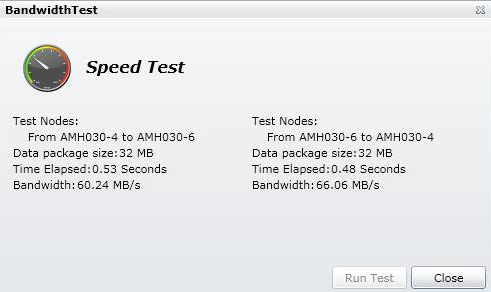
As an example of when you would conduct a bandwidth test, assume it takes a long time to sync a production server with a staging server. Use a bandwidth test to diagnose the problem.
Analyzing System Memory and Disk Space
![]() The Analysis function reports a selected server's installed memory, available memory, and available disk space.
The Analysis function reports a selected server's installed memory, available memory, and available disk space.
Each item is assigned a status of critical, warning, and OK. By default, the items are sorted in that order. To change the sort order, click the Severity column header.

Viewing Diagnostic Details
The Diagnostics Utility screen has tabs in the lower section that provides many details about your Ektron network.

Basic Diagnostics
IMPORTANT: The Diagnostics screen runs as a Windows Service. So, that service must have administrator access to perform the tests and retrieve the necessary information.
The basic diagnostics screen has several subtabs:
- Basic Connectivity—Displays server name, site URL, connection string, paths to site, Workarea, assetan external file, such as a Microsoft Word document or image, stored in Ektron. It can be managed like native Ektron content.s, private assets, uploaded files and images, asset library—Image—

- Version—Installed version of Ektron, Windows service, IIS, Visual Studio—Image—

- License—License key, status, expiration date, enabled features, maximum users—Image—

- Settings—Active Directory, SMTPSimple Mail Transport Protocol; an internet standard for electronic mail. port, and DMSDocument Management System; Ektron's way of managing assets (Microsoft Office files and other types of files) settings—Image—

- Database—Connection status, Test query, SQL version, Database server, Database name, Integrated Security (true/false).—Image—

- Connections—Status of the following services:
- server controls Web service
- content Web service
- content service
- indexing service
- Windows services 2.0, 3.0, and 4.0
—Image—
- Security—Information for the 10 default accounts installed with an Ektron sample site.
- if user exists
- if default password was changed
See Also: Securing Ektron
—Image—
- Permissions—User permission settings for these DMS folders:
- asset library\servername\site name
- \siteroot\assetmanagement\dmdata
- \siteroot\assets
See Also: Checking Document Management Permissions
—Image—
- Events—The Windows Event Log
- each event includes: event, event type, time of occurrence, description, source
- sorted by log name
—Image—
- Authentication—Active Directory and LDAPLightweight Directory Access Protocol; permits access to distributed information. settings
See Also: Using Active Directory with Ektron, Using LDAP with Ektron
—Image—
Server Details
The Server Details tab provides information about the selected server.
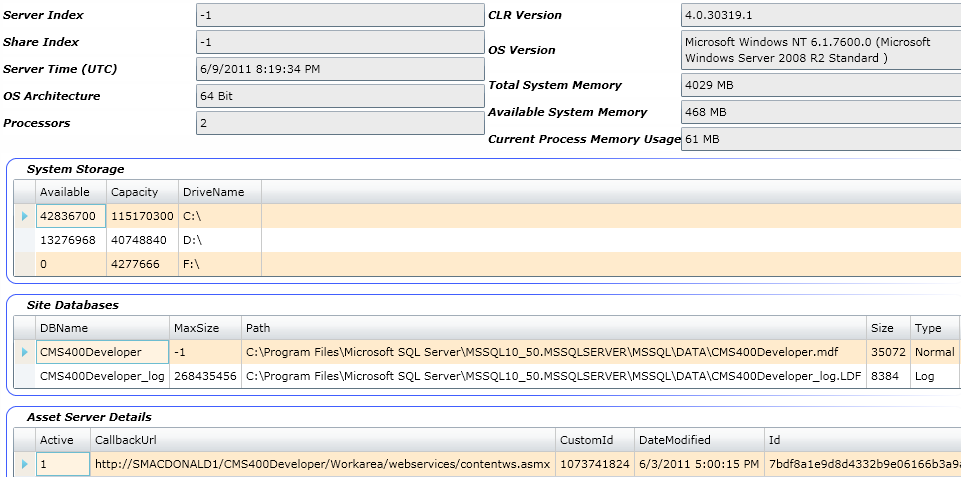
The tab displays the following information.
- Server index
- Share index
- Server time (UTC)
- OS architecture (32 or 64 bit)
- Number of Processors
- CLR Version
- OS version
- Memory: total, available, current process usage
- System storage: for each drive, the capacity and available space in megabytes
- Site databases: name, Maximum size, location, size and type
- Your website's asset server: callback URL, ID, date modified, and so on.
Sync Certificates
Use this tab to view the site's encoded eSync certificate, copied from the web.config file.

The tab also displays all remote certificates for this server. Checks in the lower section indicate the presence of certificate files on all servers. See Also: Managing eSync Security Certificates
NOTE: The tab does not indicate if the certificates on the servers in the sync relationship match.
Sync Scope
The Sync Scope tab retrieves details from the serverinfo.xml file. The tab also shows information about saved eSync profiles. See Also: Setting Up eSync Profiles

Here is an example of what appears when you click View Child Profiles.

The bottom section of the Sync Scope tab shows information for the eSync Logs. See Also: Viewing eSync Activity

Site Details
The Site Details tab shows Files over 100 MB in the site and the Knowledge and Metadata Files Screen.
- Gray circle—no files to view
- Green circle—you can view files under that server and its folders

Files over 100 MB in the site
This tab highlights website files that exceed 100 MB. Files of this size may cause problems when synchronizing or Load Balancing. This tab makes it easy to locate such files.
Knowledge and Metadata Files Screen
Use this section to view eSync Knowledge and Metadata files, which can be used to troubleshoot problems with eSync relationships.
Service Status
The Service Status tab provides information about EWSEktron Windows Service. It also lets you stop and start the service. See Also: Handling Background Processing Functions with the Ektron Windows Service
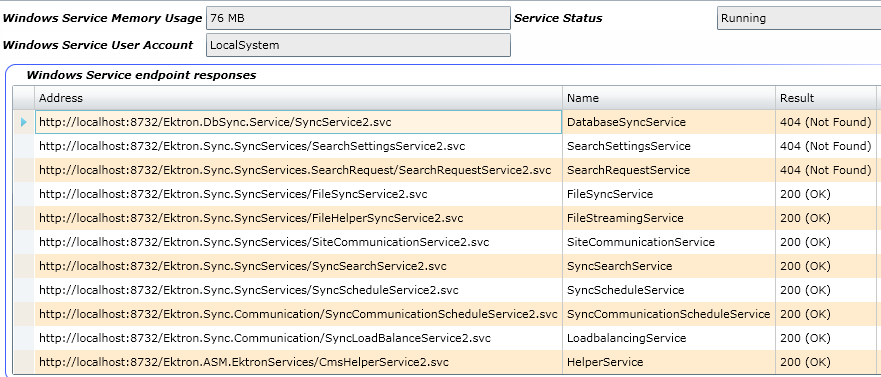
This screen tells you
- how much memory the service is using
- the user account under which it runs
- its status
- the name, address, and status of each internal Web service that EWS is running
Exporting Diagnostic Information
You can capture, save, and export diagnostic information for comparison with previous and future versions, or send it to Ektron's Support staff for diagnosis.
To capture Diagnostics information, click Export Map.
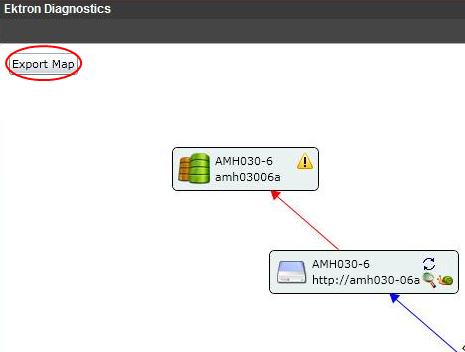
The exported file also includes a copy of configuration files and logs for servers in your website's network. This information is packed into a .zip file for easy storage and transfer. The .zip file contains the following information:
- other zipped files, which contain the captured configuration and log files.
- a
NetworkMap.ekdfile. You can load this file in the Diagnostic utility, in the Silverlight viewer, or in a text editor, such as Notepad (the saved data is XML.)

Viewing Exported Diagnostic Information
Prerequisite
The location of the exported map file on your computer. The file's name is
DiagExportdate-time.zip.
- Go to Workarea > Settings > Configuration > Diagnostics > Load Save.
- Navigate to the saved
DiagExportdate-time.zipfile. - Click Open.
- Click any node to view its information.
NOTE: You can also use the C:\Program Files\\EktronDiagnosticsService\Tools\EktronDiagnosticsWPF.exe to view a networkmap.ekd file.
